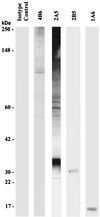Identification of novel Plasmodium gallinaceum zygote- and ookinete-expressed proteins as targets for blocking malaria transmission
- PMID: 11748169
- PMCID: PMC127631
- DOI: 10.1128/IAI.70.1.102-106.2002
Identification of novel Plasmodium gallinaceum zygote- and ookinete-expressed proteins as targets for blocking malaria transmission
Abstract
The development of transmission-blocking vaccines is one approach to malaria control. To identify novel Plasmodium zygote- and ookinete-secreted proteins as targets of blocking malaria transmission, monoclonal antibodies (MAbs) were produced against parasite-secreted proteins found in Plasmodium gallinaceum ookinete culture supernatants. Four MAbs-1A6, 2A5, 2B5, and 4B6-were identified that bound to P. gallinaceum zygotes and ookinetes in diverse patterns in terms of spatial localization on parasites, time course of antigen expression, and Western immunoblot patterns. MAbs 2A5 and 4B6 recognized more than one protein band as detected by Western immunoblot of P. gallinaceum ookinete supernatants. Beginning at 0 h postfertilization, MAb 2A5 recognized a diverse set of antigens; at 10 h postfertilization, MAb 4B6 recognized several antigens as well. MAb 1A6 recognized a single approximately 17-kDa protein, and 2B5 recognized a single approximately 32-kDa protein at 15 h postfertilization. In membrane feeding assays to assess the effect of these MAbs on P. gallinaceum infectivity for Aedes aegypti mosquitoes, the addition of MAbs 1A6 and 2B5 to infectious blood meals significantly inhibited oocyst development in the mosquito midgut. In contrast, MAb 2A5 seemed to enhance infectivity. These results demonstrate that Plasmodium ookinetes secrete proteins (in addition to previously characterized chitinases) that may be targets for blocking malaria transmission. Future investigation of ookinete-secreted neutralization-sensitive molecules should provide valuable insight into mechanisms by which ookinetes exit the blood meal, penetrate and transverse the peritrophic matrix, and invade the mosquito midgut epithelium.
Figures


Similar articles
-
Monoclonal antibody against the Plasmodium falciparum chitinase, PfCHT1, recognizes a malaria transmission-blocking epitope in Plasmodium gallinaceum ookinetes unrelated to the chitinase PgCHT1.Infect Immun. 2002 Mar;70(3):1581-90. doi: 10.1128/IAI.70.3.1581-1590.2002. Infect Immun. 2002. PMID: 11854247 Free PMC article.
-
Apical surface expression of aspartic protease Plasmepsin 4, a potential transmission-blocking target of the plasmodium ookinete.J Biol Chem. 2010 Mar 12;285(11):8076-83. doi: 10.1074/jbc.M109.063388. Epub 2010 Jan 7. J Biol Chem. 2010. PMID: 20056606 Free PMC article.
-
Functional characterization of Plasmodium berghei PSOP25 during ookinete development and as a malaria transmission-blocking vaccine candidate.Parasit Vectors. 2017 Jan 5;10(1):8. doi: 10.1186/s13071-016-1932-4. Parasit Vectors. 2017. PMID: 28057055 Free PMC article.
-
Do malaria ookinete surface proteins P25 and P28 mediate parasite entry into mosquito midgut epithelial cells?Malar J. 2005 Feb 25;4:15. doi: 10.1186/1475-2875-4-15. Malar J. 2005. PMID: 15733320 Free PMC article. Review.
-
Controlling malaria transmission with genetically-engineered, Plasmodium-resistant mosquitoes: milestones in a model system.Parassitologia. 1999 Sep;41(1-3):461-71. Parassitologia. 1999. PMID: 10697903 Review.
Cited by
-
Expression of equi merozoite antigen 2 during development of Babesia equi in the midgut and salivary gland of the vector tick Boophilus microplus.J Clin Microbiol. 2003 Dec;41(12):5803-9. doi: 10.1128/JCM.41.12.5803-5809.2003. J Clin Microbiol. 2003. PMID: 14662988 Free PMC article.
-
Analysis of von Willebrand factor A domain-related protein (WARP) polymorphism in temperate and tropical Plasmodium vivax field isolates.Malar J. 2009 Jun 23;8:137. doi: 10.1186/1475-2875-8-137. Malar J. 2009. PMID: 19549316 Free PMC article.
-
The Anopheles gambiae adult midgut peritrophic matrix proteome.Insect Biochem Mol Biol. 2009 Feb;39(2):125-34. doi: 10.1016/j.ibmb.2008.10.010. Epub 2008 Nov 11. Insect Biochem Mol Biol. 2009. PMID: 19038338 Free PMC article.
-
Proteomic analysis of zygote and ookinete stages of the avian malaria parasite Plasmodium gallinaceum delineates the homologous proteomes of the lethal human malaria parasite Plasmodium falciparum.Proteomics. 2008 Jun;8(12):2492-9. doi: 10.1002/pmic.200700727. Proteomics. 2008. PMID: 18563747 Free PMC article.
-
A Hetero-Multimeric Chitinase-Containing Plasmodium falciparum and Plasmodium gallinaceum Ookinete-Secreted Protein Complex Involved in Mosquito Midgut Invasion.Front Cell Infect Microbiol. 2021 Jan 8;10:615343. doi: 10.3389/fcimb.2020.615343. eCollection 2020. Front Cell Infect Microbiol. 2021. PMID: 33489941 Free PMC article.
References
Publication types
MeSH terms
Substances
Grants and funding
LinkOut - more resources
Full Text Sources
Other Literature Sources

